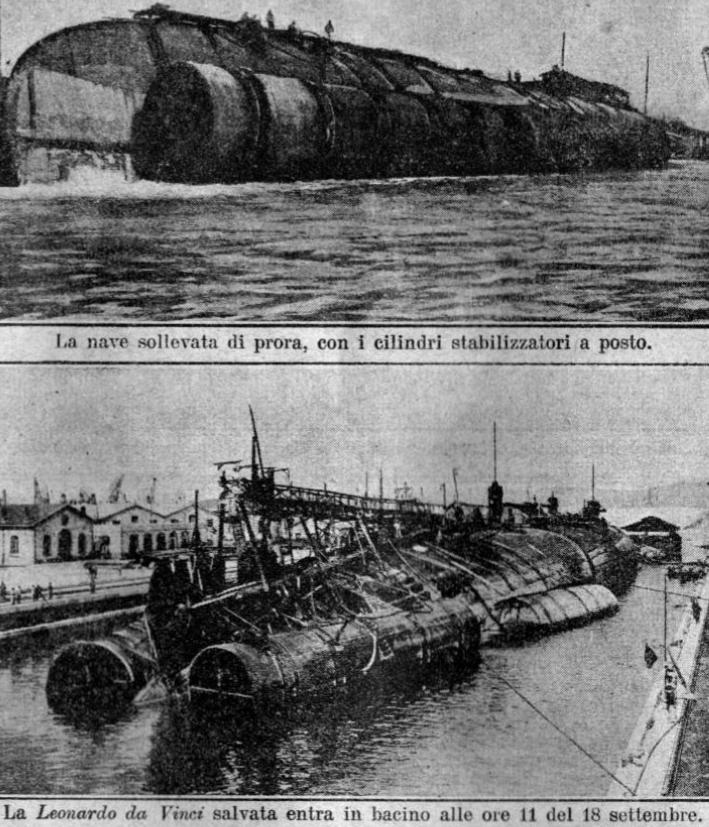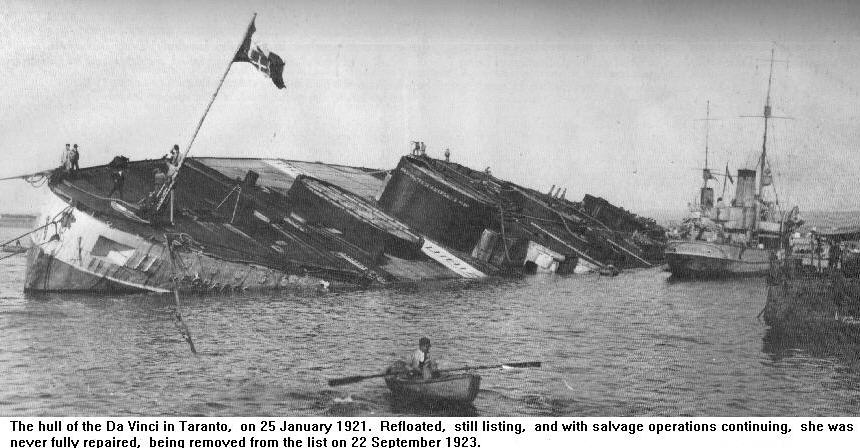SALVATE LE NAVI
IL RECUPERO DELLA LEONARDO DA VINCI NEL 1919
DOMENICA DEL CORRIERE N.40 5-12 OTTOBRE
L'ANTEFATTO... Un anno dopo il sabotaggio della Brin, nell'estate del 1916: Mancavano pochi minuti alle 23 del 2 agosto 1916 quando la corazzata dreadnought "Leonardo da Vinci", fu scossa da un rombo sordo che saliva dal fondo. Lo scafo per un istante tremò poi tornò il silenzio. Un filo di fumo rossastro usciva dai boccaporti segno evidente che anche questa volta la "santabarbara" era coinvolta. Fu ordinato l’allagamento dei depositi poppieri di munizioni, ma una violenta fiammata tra le due torri (poppiere) da 305 costrinse i marinai ad allontanarsi, mentre il comandante e gli ufficiali tentavano vani e disperati provvedimenti. Le esplosioni soffocate e distanti si fecero ravvicinate e potenti. Le piastre del ponte si schiodavano mentre la fiammata risaliva il pozzo dell’ascensore delle munizioni con una pressione incredibile. Alle 23:22 l'esplosione. Fiamme altissime illuminavano la notte mentre i marinai al lavoro venivano inghiottiti nelle voragini. Alle 23:45 la corazzata si capovolgeva. Perirono il comandante Sommi Picenardi, altri 20 ufficiali e 227 uomini dell’equipaggio

DEFINIZIONE DI "DREADNOUGHT" (o monocalibro)
The dreadnought was the predominant type of battleship of the
20th century. The revolutionary HMS Dreadnought of 1906 adopted an 'all-big-gun'
armament and steam turbine propulsion. The arrival of the dreadnoughts sparked a
new arms race, principally between Britain and Germany but reflected worldwide,
as the new class of warships became a crucial symbol of national power. In 1915
Britain produced the Queen Elizabeth, the first of the Super-Dreadnoughts. This
warship had eight 15-inch guns, each capable of firing a 1,920-pound projectile
35,000 yards. This was followed by four other ships of this design: Warspite,
Barham, Valiant and Malaya. All five ships survived the First World War, and
heavily modified, served in the Second World War. By 1914 the British Navy had
nineteen Dreadnoughts (thirteen under construction), compared with Germany's
thirteen (seven under construction). Other fleets with Dreadnoughts at sea by
1914 ? were: United States (8), France (8), Japan
(4), Austria-Hungary (2)
and
Italy (1)
(vedi di seguito le navi impostate e comunque completate
entro il conflitto che erano 5 e non una).
1909 - 12 x 12 inch guns Dante Alighieri
(disarmo 1928)
1910/1 - 13 x 12 inch guns Conte di Cavour
(disarmo 1940),
Giulio Cesare e Leonardo da Vinci
(disarmo 1923 ma di fatto radiata nel 1916) La lunghezza della Leonardo Da
Vinci era di 176 mt. con una larghezza di 28 dislocava, a pieno carico, circa
24.677 tonns e l'armamento era
costituito da 13 cannoni da 305/46 in tre torri trinate e due binate, più 8
pezzi da 120/50 e 14 da 76/50
1912 - 13 x 12 inch guns Caio Duilio and Andrea Doria
Of the older Italian ships, the Dante Alighieri was scrapped in 1928, and the
Leonardo da Vinci, after being sunk by an explosion in 1916, in 1923. The Conte
de Cavour was sunk during the daring British air raid on the anchorage at
Taranto in 1940. The Caio Duilio was torpedoed at Taranto and beached, but
raised and returned to service. The Guilio Cesare and the Andrea Doria escaped
Taranto and survived the war -- the former was turned over to the Soviet Union
in 1948 (war damage), the latter scrapped in 1957-58
LA MARINA AUSTRIACA
Dreadnought -La Viribus Unitis era una corazzata della Classe Tegetthoff, varata
nel 1914. Le 4 unità della Classe Tegetthoff (SMS Tegetthoff, SMS Szent Istvan
(affondata 1918), SMS Viribus Unitis (affondata 1918), SMS Prinz Eugen) erano
piccole, moderne ed efficienti corazzate lunghe 153m; dislocamento 21600
tonnellate; velocità massima 20.5 nodi; dodici cannoni da 305mm, più dodici da
150mm e venti da 66mm; quattro lanciasiluri; equipaggio 1097 uomini.
Semi-dreadnoughts
RADETZKY class, ERZHERZOG FRANZ FERDINAND, RADETZKY, ZRINYI,
3 ships
- 14,500t, 20 knots, 4-30.5cm/8-24cm/20-10cm, 890 crew, 1910/11
PRE-DREADNOUGHT
HABSBURG class,
ARPAD, BABENBERG, HABSBURG,
3 ships
- 8,230t, 18 knots, 3-24cm/12-15cm, 625 crew, launched 1900-02
ERZHERZOG KARL class, ERZHERZOG FERDINAND MAX, ERZHERZOG FRIEDRICH, ERZHERZOG
KARL, 3 ships
- 10,500t, 19 knots, 4-24cm/12-19cm, 750 crew, launched 1903-05
The initially small Austrian submarine force was unable to play a role outside
the Adriatic, and by early 1915 the Germans were sending U-boats into the
Mediterranean, in part to attack the Allied fleet off the Dardanelles. As Italy
had declared war on Austro-Hungary but not Germany, the German boats operated
under the Austrian ensign and were temporarily commissioned into the Austrian
Navy. Once Germany and Italy had gone to war in August 1916, German U-boats
operated under their own flag.
IL RIARMO ANGLO-TEDESCO
La guerra in atto sul mare a chi aveva fra inglesi e tedeschi la flotta più grande era cominciata nel 1898 quando Von Tirpitz decise di procedere con ostinazione nei suoi progetti di costruzioni navali (7 corazzate e 9 incrociatori, 2 pesanti e 7 leggeri). Due anni dopo quando i programmi vennero rivisti in considerazione anche dell’intervento inglese in Sud Africa (guerra boera e presidio della rotta meridionale) si raddoppiò il numero delle nuove costruzioni. Nel 1906, all'indomani della guerra russo-giapponese, il ritmo delle nuove costruzioni fu intensificato. Lo stesso avvenne nel 1908 e ancora nel 1912. La risposta inglese non si fece attendere, come diceva Churchill per ogni nave tedesca noi ne costruiremo 2, si passò subito a interventi sulla tecnologia della Dreadnought (monocalibro), ispirandosi al progetto sviluppato da un italiano, il colonnello del Genio navale Vittorio Cuniberti. Il varo della prima nave già nel 1906. Essa adottava anche un rivoluzionario motore a turbina Parsons, capace di portare le sue 22.000 tonnellate di stazza alla velocità di 21 nodi. Ben tre nodi in più rispetto alle più veloci unità corazzate delle altre marine, nonostante un dislocamento leggermente superiore. Innovativo come detto era anche l'armamento monocalibro: 10 cannoni brandeggiabili da 305 mm.!!!. Tre anni più tardi, nel 1909, l'ammiragliato inglese varò, con lievi modifiche rispetto al prototipo, altre 3 corazzate e poi ancora altre 6 nei due anni successivi. Tra il 1912 e il 1914 entrarono in servizio quattro corazzate della classe "Conqueror", quattro della classe "King George V" e quattro della classe "Iron Duke" che svilupparono ulteriormente i contenuti tecnologici delle "Dreadnought", tanto da meritare l'appellativo di "Super-Dreadnought". Imbarcavano 10 pezzi da 343 mm !! ciascuna, con una stazza a pieno carico che sfiorava le 30.000 tonn. Per mantenere un'elevata velocità, nonostante l'aumento del dislocamento, furono non solo potenziati i motori ma anche sostituito il carbone con la nafta. Pochi mesi prima dell'inizio della prima guerra mondiale la marina inglese compì un ulteriore progresso tecnologico con il varo delle corazzate veloci della classe "Queen Elisabeth": 31.500 tonnellate di stazza a pieno carico, quasi 200 metri di lunghezza. Nel corso degli anni la stazza e l'armamento delle corazzate tedesche crebbero senza tuttavia raggiungere mai il primato inglese. Alle 21.000 tonnellate delle unità della classe "Nassau" del 1910 seguirono nel 1911-12 le 25.000 tonnellate della quattro "Helgoland", dotate di cannoni da 305 mm. Pochi mesi dopo l'inizio della guerra alla flotta del Kaiser si aggiunsero quattro unità della classe "König", il cui dislocamento sfiorava le 30.000 tonn, con una velocità massima di 21 nodi.

L'ARTICOLO DELLA DOMENICA DEL CORRIERE N.40 5-12 OTTOBRE 1919
PER STRAPPARE LA PREDA AL MARE
Come si salvano le navi affondate
La dreadnought « Leonardo da Vinci » sommersa dal tradimento, è ritornata
a galla su quel mare che essa sperava, nel forte cuore pulsante del suo
equipaggio, riempire italicamente delle più belle gesta di guerra.
Il suo ritorno alla superficie è vera gloria dell’industria e del genio navale
d’Italia, cui non scarseggiano i precedenti prodigiosi. Il salvataggio delle
navi affondate è un’impresa ardua cui concorrono menti direttive, mezzi tecnici
e uomini di fegato: questi ultimi sono i palombari, la cui origine è più antica
di quanto si creda. Dice infatti Aristotele in "Opera problemata": Si può dare
agli uomini sommersi la facoltà di respirare procurando loro un vaso capovolto,
il quale non si riempie d’acqua, ma conserva l’aria, qualora sia fatto
discendere perpendicolarmente a forza. Se anche per poco tale vaso s’inclini,
l’acqua lo riempie ». E’ il principio su cui si basa la campana palombarica.
Oggi però i lavoratori sottomarini scendono nelle profondità del mare muniti di
perfetti scafandri (dal greco, batteLlo-uomo), che il genio universale di
Leonardo da Vinci divinò descrivendo un suo apparecchio.
I più famosi palombari del mondo si riassumono nei nome di una famiglia
italiana, ove la professione è diventata eredità: i Serra che già recuperarono
la Sultan affondata il 15 marzo del 1888 a Malta (Comino). ......
( I livornesi Serra, Antonio insieme ai suoi fratelli
ed a altri palombari labronici nel 1911, disincagliarono fra le altre
l’incrociatore “San Giorgio” a Napoli, la corazzata “Leonardo da Vinci” a
Taranto come stiamo dicendo e la corazzata “Viribus Unitis” affondata a Pola).
L'articolo come spesso succede è avaro di indicazioni trattandosi di argomenti
ancora soggetti al segreto militare. Debbo quindi ricorrere a un servizio del
corrispondente del N.Y. Times sotto a fine pagina, ma di 2 anni successivi,
per capire come si svolsero le operazioni di recupero dettate più da spirito di
rivincita che da necessità di riarmare la nave. Era necessario invece liberare i
fondali e recuperare il ferro.

|
|
||
|
ITALIAN DREADNOUGHT BLOWS UP; 300 DROWN The Leonardo da Vinci sinks in Taranto harbor when explosion follows
kitchen fire. |
ITALIAN DREADNOUGHT TO BE TURNED OVER Naval Men Go to See the Righting of Leonardo da Vinci at Sea Special Cable to The New York Times co. (copyright) ROME, Jan.23.(1922). All allied naval Attachés,
lncludlng Captain ,Joseph Reeves American Naval Attaché have left for
Taranto to be present at a triumphant setting afloat of the Italian
dreadnought Leonardo da Vinci, which was sunk on Aug. 2 1916 by order of
its commander, Sommi Picenardi. Traitors paid by Austria had placed an
infernal rnachine in its powder magazine. The commander, in order to save
the city and the other allied ship in port ordered the opening ot the
va1ve causing the dreadnought to turn on its side and disappear, together
with him. |
|